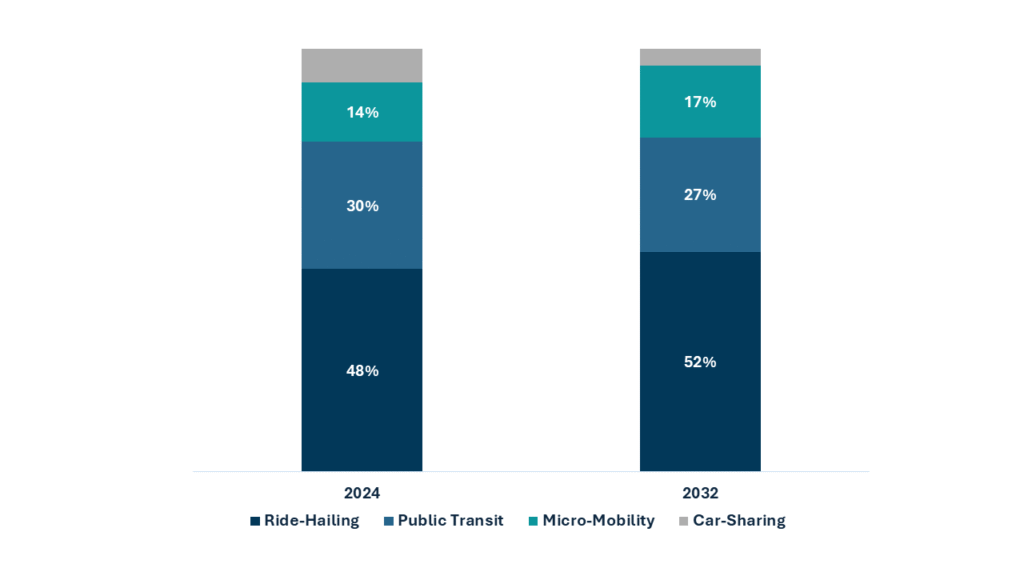Defining the Shift: From Ownership to Usership
Mobility-as-a-Service (MaaS) integrates various transport services such as public transit, ride-hailing, car-sharing, bike-sharing, and scooter rentals into a single, accessible, on-demand platform. Think of it as a “Netflix for Transportation,” where the user pays for mobility outcomes (point A to B) rather than the physical asset (the car).
The driving forces are multifaceted:
-
-
- Urbanization & Congestion: By 2050, over 65% of the world’s population will live in urban areas. Cities are actively promoting alternatives to private car ownership to reduce congestion and pollution.
- Digital Native Demographics: Generations Y and Z exhibit a markedly lower propensity for car ownership, prioritizing access over assets and digital convenience over maintenance burdens.
- Technology Convergence: The proliferation of smartphones, ubiquitous connectivity, and advances in AI-powered routing and payment systems have made seamless MaaS platforms technically feasible.
- Regulatory Pressure: EU “Fit for 55” and similar global mandates are artificially increasing the cost of individual ownership through congestion charges and ICE bans, while subsidizing shared and electric mobility solutions.
- Economic Rationalization: In dense urban corridors, the total cost of ownership (TCO) for a private vehicle is becoming financially irrational compared to on-demand services. This is a TCO argument you are positioned to lose.
-
The competitive landscape is a dynamic battleground:
-
-
- Tech Giants & Aggregators: Companies like Uber, Lyft, and Didi are leveraging their vast user networks to become dominant MaaS aggregators.
- Specialized MaaS Providers: Start-ups like Whim (Finland) and Citymapper (UK) are proving the model in specific, dense urban corridors.
- Public Transport Authorities: Forward-thinking cities are developing their own MaaS ecosystems, integrating public and private options.
- Automotive OEMs: The response from traditional manufacturers has varied, ranging from acquisition (e.g., Stellantis’s Free2move) to partnership and in-house development.
-

MaaS Adoption Trends by Mode (2024–2032)
Strategic Implications for Automotive Incumbents
The rise of MaaS presents both an existential threat and a monumental opportunity. The traditional volume-based model of selling vehicles is being challenged.
1. The Threat to Volume:
A single shared vehicle can displace up to 15 privately owned vehicles. While this displacement is most acute in dense urban centers – the primary testing grounds for autonomy – it creates a tangible risk of cannibalizing new car sales. Your most valuable future customers may never visit a dealership.
2. The Opportunity in New Value Chains:
The value in the MaaS ecosystem migrates from the point of sale to the lifetime of service. Profit pools will emerge in new areas:
The Strategic Migration of Automotive Value Pools
|
Legacy Value Pool (Threatened) |
Emerging Value Pool (Opportunity) |
Critical Strategic Question for the Board |
|
Vehicle Sales Margin |
Fleet Management & Monetization: Lifetime revenue from purpose-built vehicles (PBVs) via subscription, usage fees, or B2B leasing. | Do we have a dedicated business unit with P&L responsibility for designing, financing, and operating a commercial fleet? |
|
After-Sales Parts & Service |
Predictive Maintenance & Uptime Assurance: High-margin service contracts guaranteeing 99%+ operational readiness for MaaS fleets. | Is our service organization structured to serve high-velocity B2B fleet operators, not just retail customers? |
|
Traditional Automotive Financing |
MaaS-specific Financial Instruments: Asset-backed securities for EV fleets, usage-based insurance, and subscription finance products. | Is our captive finance arm developing innovative products for the usership economy, or just optimizing loans for ownership? |
|
Brand Value via Marketing |
Platform & Data Dominance: Ownership of the customer interface and the priceless data on mobility patterns it generates. | The most critical question: Are we building, buying, or partnering to own the customer relationship in the MaaS ecosystem? |
3. The Data Imperative:
MaaS platforms generate petabytes of invaluable data on consumer mobility patterns. This data is the new oil. It can inform everything from future vehicle design (e.g., designing purpose-built vehicles for MaaS, not retrofitting consumer cars) to dynamic pricing and urban planning. OEMs who fail to capture and leverage this data will be relegated to low-margin hardware providers.
Strategic Challenges and Mitigation
The MaaS ecosystem faces several hurdles that require strategic foresight:
Interoperability: Fragmented systems across public and private providers hinder seamless integration.
-
-
- Solution: Develop standardized APIs and foster PPP, as exemplified by MaaS Global’s collaboration with Unipol in Italy.
-
Regulatory Complexity: Varying data privacy and transport regulations across regions create compliance risks.
-
-
- Solution: Engage with policymakers to co-create frameworks, as seen in Singapore’s Smart Nation initiative.
-
Cybersecurity: With MaaS platforms handling sensitive user data, cyberattacks pose a significant threat.
-
-
- Solution: Implement end-to-end encryption and AI-driven threat detection, drawing from best practices in fintech.
-
A Strategic Roadmap for Automotive Leaders
Based on our engagements with global OEMs, we recommend a dual-path strategy:
1. The Offensive Play: “OEM-as-a-Service-Provider”
-
-
- Objective: Control the ecosystem. Launch or acquire a MaaS platform to own the customer relationship and brand experience.
- Action: Establish an independent business unit with a separate tech stack and agile operating model. Fund it to compete with tech-native players, not to satisfy traditional automotive ROI cycles. See: BMW’s ReachNow (initial phase), FREE NOW (Daimler/BMW JV).
-
2. The Defensive Play: “Strategic Enabler & Fleet OEM”
-
-
- Objective: Become the dominant B2B supplier. If you cannot win the platform war, ensure every other platform runs on your hardware and services.
- Action: Accelerate development of Purpose-Built Vehicles (PBVs):
- Radical cost-down engineering for TCO.
- Durable, easy-to-clean interiors.
- Modular designs for easy repair and upgradability.
- Offer bundled “Mobility-in-a-Box” solutions: PBVs + financing + maintenance.
-
3. The Asymmetric Play: “Targeted Partnerships & Investments”
-
-
- Objective: De-risk, learn, and gain optionality.
- Action: Forge non-dilutive partnerships with public transit authorities, tech firms, and even other OEMs. Make strategic venture investments in high-potential MaaS enablers (e.g., AI routing, battery health software, fleet management SaaS). This is your strategic radar.
-
Regional Strategies for MaaS Market Entry and Growth
-
-
- Asia Pacific (Over 30% Market Share): Leverage high population density and government support in China and India. For instance, Didi Chuxing’s integration of AI-driven routing and EV fleets offers a blueprint for scaling in dense urban markets.
- Europe: Capitalize on robust public transit systems and MaaS pioneers like Whim. Focus on cross-border interoperability to address the EU’s fragmented regulatory landscape.
- North America: Invest in autonomous vehicle integration, with companies like Waymo leading trials in San Francisco and Phoenix. Prioritize partnerships with tech giants to enhance platform scalability.
- Emerging Markets: In Latin America and Africa, tailor solutions to local needs, such as Brazil’s focus on decarbonization through EV-based MaaS pilots.
-
Conclusion and Immediate Next Steps
The MaaS transition is a certainty. The only variables are the timing of its impact on your sales volume and your degree of preparedness. Following are the immediate actions:
-
-
- Commission a TCO Model: Task finance with building a granular model comparing the lifetime revenue of a vehicle sold to a retail customer vs. the potential lifetime value of the same vehicle deployed in a MaaS fleet.
- Form a MaaS War Room: Assemble a cross-functional team (Product, Finance, Service, Sales, Digital) to pressure-test the strategies against your specific corporate strengths.
- Board Approval for CapEx: Allocate dedicated capital in the next budget cycle for one offensive, defensive, or asymmetric play. This cannot be funded from existing product development budgets.
-
The goal is not to abandon your core – it is to defend it by boldly investing in the new value chains that will define the next era of mobility.
Schedule your confidential executive briefing to define a targeted MaaS strategy and safeguard your core revenue.



